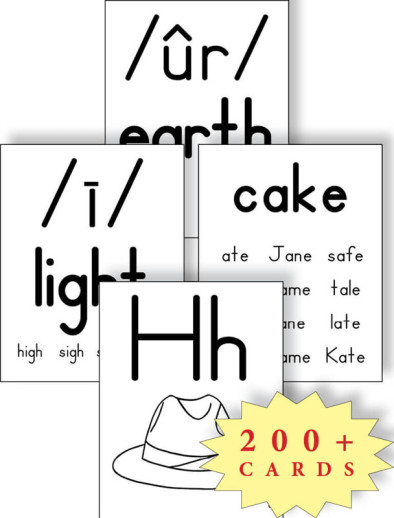We use cookies to make your experience better. To comply with the new e-Privacy directive, we need to ask for your consent to set the cookies. Learn more.
Phonics Flashcards
The most complete set of phonics flashcards I've ever encountered. The numbered cards have a letter or letter group plus an illustrative picture on the front side. The back side has a word that corresponds to the picture plus other words that have the same sound. Letters or letter groups are shown on one side or the other with diacritical marks to show the sound. There are 26 alphabet cards; 20 cards with letters with more than one sound (long/short vowels ad Y, C, G, S); 8 with consonant teams; 35 with consonant blends; 17 with vowel teams; 14 with second set of consonant teams; 15 with a second set of vowel teams; 15 with R-controlled vowels; 14 with advanced letter teams; and 110 cards with common and sight words for a total of 284 cards. The white cards (4.25" x 5.5") are portrait oriented and have a rounded upper right corner. ~ Janice
Phonograms are letters or letter teams that represent (spell) one of the 44 sounds of the English language. English spelling is the most complex and irregular of any of the modern Western languages. There are nearly 200 phonograms used to spell our 44 English sounds.
Many phonograms have more than one sound, and many sounds are spelled by more than one phonogram. Phonogram cards help students recognize the great variety of spelling patterns in English.
The nine phonogram categories in this set are organized for easy reference and to give some rational order to the irregularities of English spelling. While the order of the categories is from the simpler to the more complex, within each category there may be advanced phonograms that you will want to postpone for later attention. Also, the order of the categories is somewhat flexible after Section I. For instance, you may choose to teach Sections III and IV before the long vowels in Section II. Use these cards in the order that matches your phonics and reading program.
Phonogram cards can be combined and recombined to help students see the multiple ways a sound can be spelled and the multiple sounds for a particular phonogram. For instance, the vowel team ea has two long sounds and one short sound in Section V. When all phonograms have been covered individually, group them together to practice the three sounds of ea.
Programs in this section focus primarily on teaching children to read, and may not provide comprehensive instruction in reading comprehension, spelling, writing, or other language skills. Arranged roughly by grade.
A surprise from a publisher known for its Latin programs! First Start Reading from Memoria Press is deceptively simple with an emphasis on vowel-consonant/word-families phonics and a serious focus on correct pencil grip and letter formation. Yes, in a day and age when penmanship is often ignored, they've chosen to make it a central part of their approach to reading. And, I have to confess it makes sense. After all, it serves as a kinesthetic reinforcement activity.
First Start Reading is a traditional and uncomplicated approach to phonics. After starting with ear training, vowel-consonant blending with unvoiced (m, n, s, r, f, t) consonants is first. Teach one sound for each phonogram at a time. Practice the new phonogram and its sound in a word family list with extensive practice in CVC words. Practice reading words and sentences as early as possible and reinforce learning with manuscript printing and that strong emphasis on correct pencil grip and letter formation. Include a small number of sight words. Throw in a couple of clever "tricks" for dealing with b-d confusion and you're done! Once mastered, these skills should take the student competently into a first grade reading level.
The entire program consists of four Student Worktexts (A-D) and a Teacher's Guide. The worktexts are about half letter presentation, blending, and reading practice and half writing practice space - on facing pages. Black and white line art drawings that can be colored keep the look clean. Letter formation clues include directional arrows on sample letters and starting point "dots." The four Student Worktexts are from 70 to 108 pages. The Teacher's Guide starts with an introduction that covers all the basics - syllabi for the Worktexts, the phonics approach, getting started, phonics recitation (an important element of the program), and pencil grip instruction. The rest of the book - except for a few reproducible visuals in the appendix - are wrap-around lesson plans. The lesson plans include general information for the teacher as well as scripted instructions for the student. As mentioned, half of every lesson is writing instruction, which serves as phonics reinforcement.
We expect easy-to-use from Memoria Press and we're not disappointed here. There's an amazing amount of quality phonics/reading instruction in a very reasonably priced package. You might be wondering what to do after this course. Perhaps Memoria will publish a sequel but until then they recommend Primary Phonics as a follow-up. First Start Reading is obviously designed as a lead-in to another new program from Memoria: StoryTime Treasures. Check our reading section for more information. ~ Janice
| Product Format: | Other |
|---|---|
| Brand: | Memoria Press |
| Author: | Cheryl Lowe |
| Grades: | K-2 |
| ISBN: | 9781615385973 |
| Length in Inches: | 5.5 |
| Width in Inches: | 4.25 |
| Height in Inches: | 3.75 |
| Weight in Pounds: | 2.9 |

